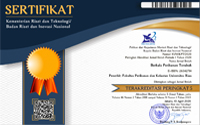MANGROVE COMMUNITY STRUCTURE AT MANGROVE ECOTOURISM AREA IN KAYU ARA PERMAI VILLAGE, SIAK REGENCY
Abstract
This research was conducted on July - August, 2020 in mangrove ecotourism area of
Kampung Kayu Ara Permai, Siak Regency. The purpose of this study was to obtain the
value of density, frequency, mangrove important value index (INP Mangrove),
dominance index value and mangrove diversity index in the mangrove ecotourism area
of Kampung Kayu Ara Permai. Five serial plots with provisions of 10x10 meters
2
for
2
trees, 5x5 meters
for shrubs, and 2x2 meters
2
for seedlings. Each plot identified species,
measured stem diameter, and the number of individual mangroves. Vegetation analysis
using Mueller and Dumbois formulas to get the value of diversity, frequency, dominance
and importance of plants. The results showed that nine species of mangrove vegetation
were found: Avicennia alba, Avicennia marina, Bruguiera gymnoriza, Bruguiera
sexangula, Bruguiera sylindrica, Lumnitzera littorea, Rhizophora apiculata, Rhizophora
mucronata, and Rhizophora stylosa. The highest importance index was found in
Rhizophora apiculata (102.4%). Mangrove diversity in this area is high (5.28) and is
dominated by Rhizophora apiculata. The high diversity of mangroves is due to the
preservation of this area by community groups.
Keywords
Full Text:
PDFReferences
Abdulhaji, R., 2001. Problem of issues affecting biodiversity in Indonesia. Situation analysis. Paper.
Presented in Workshop on Tanning Net Assessment for Biodiversity Conservation in Indonesia
-2 Februari 2001, Bogor, Indonesia.
Arief & Arifin. 2003. Hutan Mangrove Fungsi dan Manfaatnya. Yogyakarta: Kanisus
Ashton, E.C., & D.J., Macintosh. 2002. Preliminary assessment of the plant diversity and community
ecology of the Sematan mangrove forest, Sarawak, Malaysia. Forest Ecology and Management, 166, 111–129.
Barbour, M.G., J.H., Burk, & W.D., Pits. 1987. Terrestrial plant ecology. Menlo Park. Benjamin
Cumming Pub. Co. Inc. New York.
Bengen, D.G., 2001. Pedoman Teknis Pengenalan dan Pengelolaan Ekosistem Mangrove. Pusat Kajian
Sumberdaya Pesisir dan Lautan. Institut Pertanian Bogor. Bogor, Indonesia
Iswahyudi, C., Kusmana, A., Hidayat, & B.P., Noorachmat. 2019. Evaluasi Kesesuaian Lahan Untuk
Rehabilitasi Hutan Mangrove Kota Langsa Aceh. Jurnal Matematika Sains dan Teknologi,
(1), 45–56.
Kathiresan, L & B.L., Bingham. 2001. Biology of mangroves and mangrove ecosystems. Advances in
Marine Biology, 40, 81–251.
Keputusan Menteri Lingkungan Hidup. 2004. Tentang Kriteria baku dan Pedoman Penentuan
Kerusakan Mangrove. Nomor 201/Kepmen-LH/2013.
Odum, E.P. 1993. Dasar – dasar ekologi. Edisi ketiga. Penerjemah Tjahjono Samingan. Gajah Mada
University Press. Yogyakarta.
Pleimo & Wabang. 2020. Study of Community Perception of Village Government Regulations in
Protecting The Mangrove Forest Area ff Aimoli Village. Berkala Perikanan Terubuk, 49(1),
-763.
Rochana, E. 2010. Citing Computer References. Ekosistem Mangrove dan Pengelolaanya di Indonesia.
Artikel Ilmiah.
Rusila, N.Y., M. Khazali, dan I.N.N., Suryadiputra. 1999. Panduan pengenalan mangrove di Indonesia.
PHKA/WI-IP. Bogor.
Suwondo E, Febrita, & F., Sumanti. 2006. Struktur komunitas gastropoda di hutan mangrove di Pulau
Sipora. Jurnal Biogenesis, 2(1), 25-29.
Usman, L., Syamsuddin, & S.N., Hamzah. 2013. Analisis Vegetasi Mangrove di Pulau Dudepo
Kecamatan Anggrek, Kabupaten Gorontalo Utara. Jurnal Nike, 1(1): 11–17.
Warongan, C.W.A., 2009. Kajian Ekologi Ekosistem Mangrove untuk Rehabilitasi di Desa Tiwoho
Kecamatan Wori Kabupaten Minahasa Utara Prov. Sulawesi Utara. Tesis Pasca Sarjana Institut
Pertanian Bogor. Bogor.
DOI: http://dx.doi.org/10.31258/terubuk.49.2.1079-1084
Refbacks
- There are currently no refbacks.
Copyright (c) 2021 Tika Nisari, Muhammad Fauzi, Ridwan Manda Putra

This work is licensed under a Creative Commons Attribution 4.0 International License.












